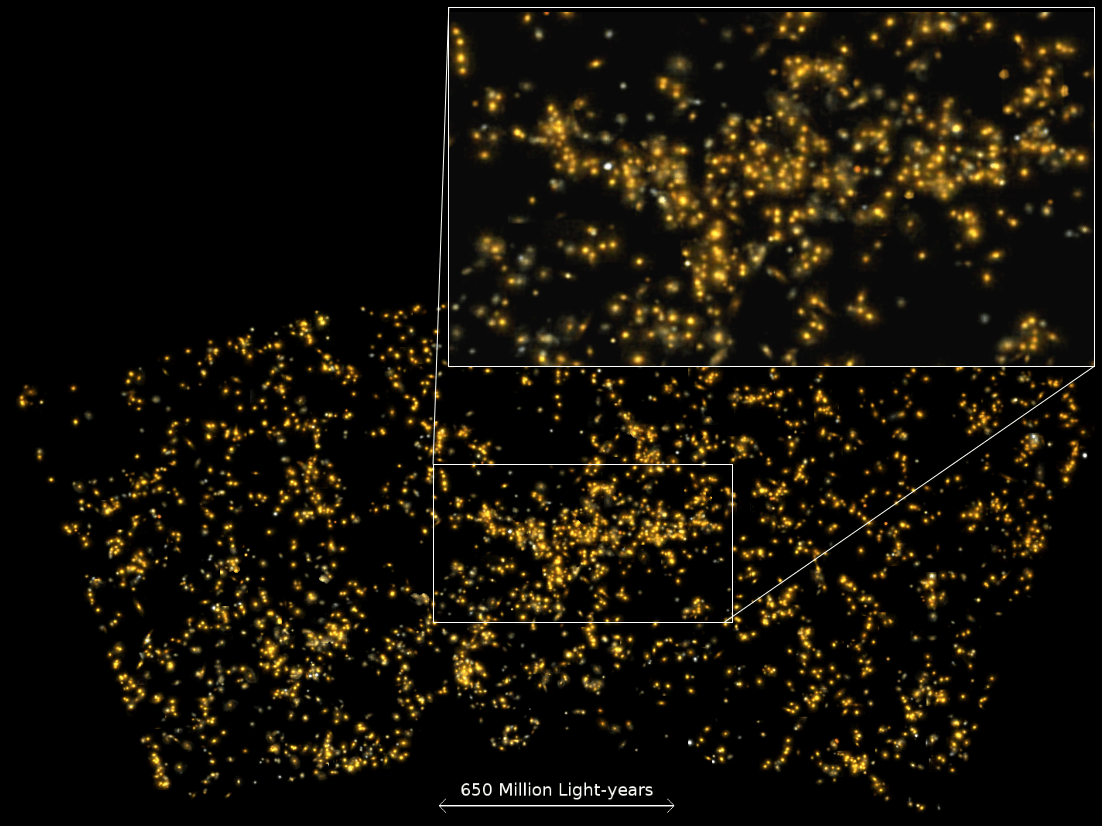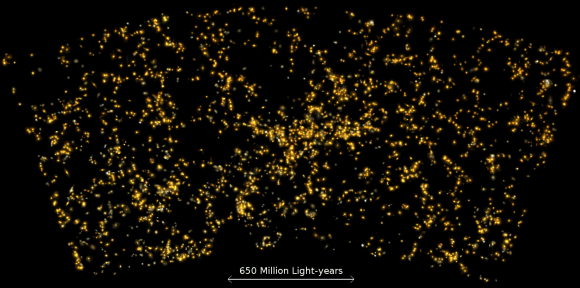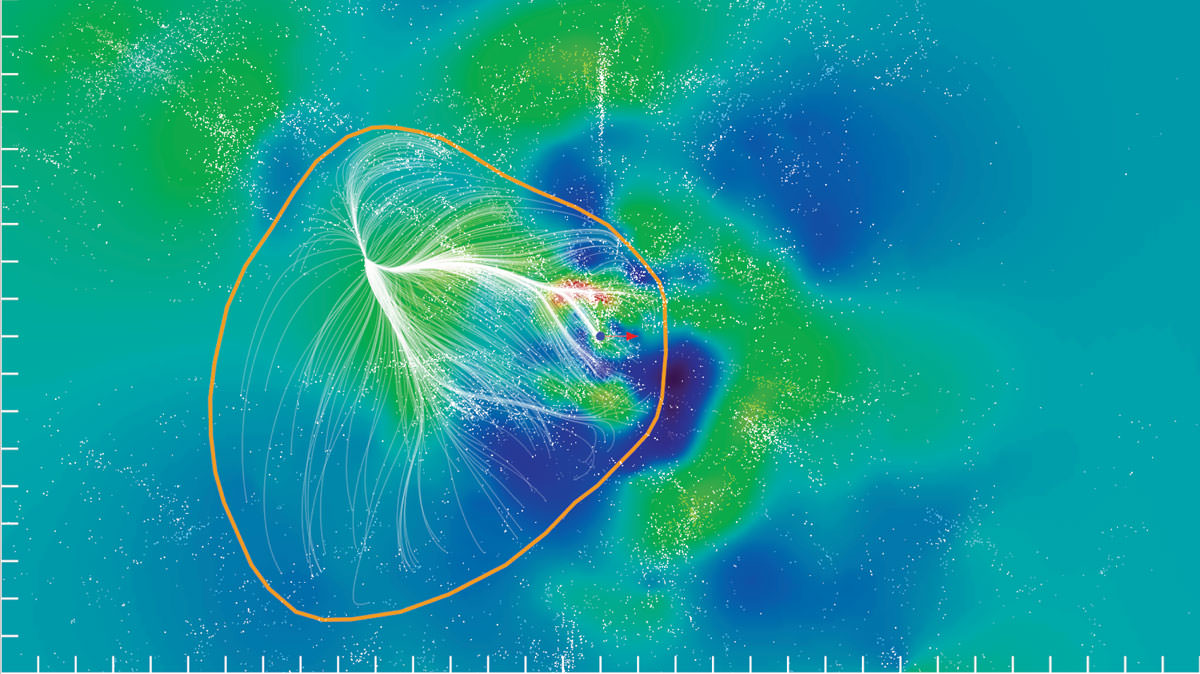The Earth’s place in space is a fairly familiar one with it orbiting an average star. The star – our Sun – orbits the centre of our Galaxy the Milky Way. From here onwards, the story is less well known. The Milky Way is part of a large structure called the Laniakea Supercluster which is 250 million light years across! That really is a whacking great area of space and it contains at least 100,000 galaxies. There are larger superclusters though like the newly discovered Einasto Supercluster which measures an incredible 360 million light years across and is home to 26 quadrillion stars!
Continue reading “Astronomers Find the Most Massive Supercluster to Date”This is the One of the Largest Structures We Know of in the Universe

The Milky Way Galaxy, which measures 100,000 to 180,000 light years (31 – 55 kiloparsecs) in diameter and contains 100 to 400 billion stars, is so immense that it boggles the mind. And yet, when it comes to the large-scale structure of the Universe, our galaxy is merely a drop in the bucket. Looking farther, astronomers have noted that galaxies form clusters, which in turn form superclusters – the largest known structures in the Universe.
The supercluster in which our galaxy resides is known as the Laniakea Supercluster, which spans 500 million light-years. But thanks to a new study by a team of Indian astronomers, a new supercluster has just been identified that puts all previously known ones to shame. Known as Saraswati, this supercluster is over 650 million light years (200 megaparsecs) in diameter, making it one the largest large-scale structures in the known Universe.
The study, which recently appeared in The Astrophysical Journal under the title “Saraswati: An Extremely Massive ~ 200 Megaparsec Scale Supercluster“, was conducted by astronomers from the Inter University Center for Astronomy & Astrophysics (IUCAA) and the Indian Institute of Science Education and Research (IISER), with assistance provided by a number of Indian universities.

For the sake of their study, the team relied on data obtained by the Sloan Digital Sky Survey (SDSS) to examine the large-scale structure of the Universe. In the past, astronomers have found that the cosmos is hierarchically assembled, with galaxies being arranged in clusters, superclusters, sheets, walls and filaments. These are separated by immense cosmic voids, which together create the vast “Cosmic Web” structure of the Universe.
Superclusters, which are the largest coherent structures in the Cosmic Web, are basically chains of galaxies and galaxy clusters that can extend for hundreds of millions of light years and contain trillions of stars. In the end, the team found a supercluster located about 4 billion (1226 megaparsecs) light-years from Earth – in the constellation Pisces – that is 600 million light-years wide and may contain the mass equivalent of over 20 million billion suns.
They gave this supercluster the name “Saraswati”, the name of an ancient river that played an important role in the emergence of Indian civilization. Saraswait is also the name of a goddess that is worshipped in India today as the keeper of celestial rivers and the goddess of knowledge, music, art, wisdom and nature. This find was particularly surprising, seeing as how Saraswati was older than expected.
Essentially, the supercluster appeared in the SDSS data as it would have when the Universe was roughly 10 billion years old. So not only is Saraswati one of the largest superclusters discovered to date, but its existence raises some serious questions about our current cosmological models. Basically, the predominant model for cosmic evolution does not predict that such a superstructure could exist when the Universe was 10 billion years old.

Known as the “Cold Dark Matter” model, this theory predicts that small structures (i.e. galaxies) formed first in the Universe and then congregated into larger structures. While variations within this model exist, none predict that something as large as Saraswati could have existed 4 billion years ago. Because of this, the discovery may require astronomers to rethink their theories of how the Universe became what it is today.
To put it simply, the Saraswati supercluster formed at a time when Dark Energy began to dominate structure formation, replacing gravitation as the main force shaping cosmic evolution. As Joydeep Bagchi, a researcher from IUCAA and the lead author of the paper, and co-author Shishir Sankhyayan (of IISER) explained in a IUCAA press release:
‘’We were very surprised to spot this giant wall-like supercluster of galaxies… This supercluster is clearly embedded in a large network of cosmic filaments traced by clusters and large voids. Previously only a few comparatively large superclusters have been reported, for example the ‘Shapley Concentration’ or the ‘Sloan Great Wall’ in the nearby universe, while the ‘Saraswati’ supercluster is far more distant one. Our work will help to shed light on the perplexing question; how such extreme large scale, prominent matter-density enhancements had formed billions of years in the past when the mysterious Dark Energy had just started to dominate structure formation.’’
As such, the discovery of this most-massive of superclusters may shed light on how and when Dark Energy played an important role in supercluster formation. It also opens the door to other cosmological theories that are in competition with the CDM model, which may offer more consistent explanations as to why Saraswati could exist 10 billion years after the Big Bang.
One thing is clear thought: this discovery represents an exciting opportunity for new research into cosmic formation and evolution. And with the aid of new instruments and observational facilities, astronomers will be able to look at Saraswait and other superclusters more closely in the coming years and study just how they effect their cosmic environment.
Further Reading: IUCAA, The Astrophysical Journal
Meet Laniakea, Our Home Supercluster

Our cosmic address extends well beyond Earth, past the Milky Way and toward the farthest reaches of the universe. But now astronomers are adding another line: the Laniakea Supercluster, which takes its name from the Hawaiin term “lani” meaning heaven and “akea” meaning spacious or immeasurable.
And the name is true to its meaning. The supercluster extends more than 500 million light-years and contains the mass of 100 quadrillion Suns in 100,000 large galaxies. This research is the first to trace our local supercluster on such a large scale.
“We have finally established the contours that define the supercluster of galaxies we can call home,” said lead researcher R. Brent Tully, from the University of Hawaii’s Institute for Astrophysics, in a news release. “This is not unlike finding out for the first time that your hometown is actually part of much larger country that borders other nations.”
Superclusters — aggregates of clusters of galaxies — rank among the largest structures in the universe. Although these structures are interconnected in a web of filaments, their exact outlines and boundaries are hard to define.
Large three-dimensional maps (think Sloan Digital Sky Survey) calculate a galaxy’s location based on its galactic redshift, the shifts in its spectrum due to its apparent motion as space itself expands. But Tully and colleagues used peculiar redshifts, the shifts in a galaxy’s spectrum due to the local gravitational landscape, instead.
In other words, the team is mapping the galaxies by examining their impact on the motions of other galaxies. A galaxy caught in the midst of multiple galaxies will find itself in a massive tug-of-war, where the balance of the surrounding gravitational forces will dictate its motion.
Typically this method is only viable for the local universe where the peculiar velocities are high enough compared with the expansion velocities, which increase with distance (a galaxy recedes faster the farther away it is). But Tully and colleagues used a new algorithm, which revealed the large-scale patterns created by galaxies’ motions.
Not only did this allow them to map our home supercluster, but to clarify the role of the Great Attractor, a dense region in the vicinity of Centaurus, Norma, and Hydra clusters that influences the motion of our Local Group and other groups of galaxies. They revealed that the Great Attractor is a large gravitational valley that draws all galaxies inward.
The team also discovered other structures, including a region named Shapley, toward which Laniakea is moving.
The findings have been published in the Sept. 4 issue of Nature.
What Is The Great Attractor?
There’s a strange place in the sky where everything is attracted. And unfortunately, it’s on the other side of the Milky Way, so we can’t see it. What could be doing all this attracting?
Just where the heck are we going? We’re snuggled in our little Solar System, hurtling through the cosmos at a blindingly fast of 2.2 million kilometers per hour. We’re always orbiting this, and drifting through that, and it’s somewhere out in the region that’s not as horrifically terrifying as what some of our celestial neighbors go through. But where are we going? Just around in a great big circle? Or an ellipse? Which is going around in another circle… and it’s great big circles all the way up?
Not exactly… Our galaxy and other nearby galaxies are being pulled toward a specific region of space. It’s about 150 million light years away, and here is the best part. We’re not exactly sure what it is. We call it the Great Attractor.
Part of the reason the Great Attractor is so mysterious is that it happens to lie in a direction of the sky known as the “Zone of Avoidance”. This is in the general direction of the center of our galaxy, where there is so much gas and dust that we can’t see very far in the visible spectrum. We can see how our galaxy and other nearby galaxies are moving toward the great attractor, so something must be causing things to go in that direction. That means either there must be something massive over there, or it’s due to something even more strange and fantastic.
When evidence of the Great Attractor was first discovered in the 1970s, we had no way to see through the Zone of Avoidance. But while that region blocks much of the visible light from beyond, the gas and dust doesn’t block as much infrared and x-ray light. As x-ray astronomy became more powerful, we could start to see objects within that region. What we found was a large supercluster of galaxies in the area of the Great Attractor, known as the Norma Cluster. It has a mass of about 1,000 trillion Suns. That’s thousands of galaxies.

While the Norma Cluster is massive, and local galaxies are moving toward it, it doesn’t explain the full motion of local galaxies. The mass of the Great Attractor isn’t large enough to account for the pull. When we look at an even larger region of galaxies, we find that the local galaxies and the Great Attractor are moving toward something even larger. It’s known as the Shapley Supercluster. It contains more than 8000 galaxies and has a mass of more than ten million billion Suns. The Shapley Supercluster is, in fact, the most massive galaxy cluster within a billion light years, and we and every galaxy in our corner of the Universe are moving toward it.
So as we hurtle through the cosmos, gravity shapes the path we travel. We’re pulled towards the Great Attractor, and despite its glorious title, it appears, in fact to be a perfectly normal collection of galaxies, which just happens to be hidden.
What do you think? What are you hoping we’ll discover over in the region of space we’re drifting towards?
And if you like what you see, come check out our Patreon page and find out how you can get these videos early while helping us bring you more great content!
Structure of the Universe

[/caption]The large-scale structure of the Universe is made up of voids and filaments, that can be broken down into superclusters, clusters, galaxy groups, and subsequently into galaxies. At a relatively smaller scale, we know that galaxies are made up of stars and their constituents, our own Solar System being one of them.
By understanding the hierarchical structure of things, we are able to gain a clearer visualization of the roles each individual component plays and how they fit into the larger picture. For example, if we go down to the world of the very small, we know that molecules can be chopped down into atoms; atoms into protons, electrons, and neutrons; then the protons and neutrons into quarks and so on.
But what about the very large? What is the large-scale structure of the universe? What exactly are superclusters and filaments and voids? Let’s start by looking at galaxy groupings and move on to even larger structures.
Although there are some galaxies that are found to stray away by their lonesome, most of them are actually bundled into groups and clusters. Groups are smaller, usually made up of less than 50 galaxies and can have diameters up to 6 million light-years. In fact, the group in which our Milky Way is a member of is made up of only a little over 40 galaxies.
Generally speaking, clusters are bunches of 50 to 1,000 galaxies that can have diameters of up to 2-10 megaparsecs. One very peculiar property of clusters is that the velocities of their galaxies are supposed to be too high for gravity alone to keep them bunched together … and yet they are.
The idea that dark matter exists starts at this scale of structure. Dark matter is believed to provide the gravitational force that keeps them all bunched up.
A great number of groups, clusters and individual galaxies can come together to form the next larger structure – superclusters. Superclusters are among the largest structures ever to be discovered in the universe.
The largest single structure to be identified is the Sloan Great Wall, a vast sheet of galaxies that span a length of 500 million light-years, a width of 200 million light-years and a thickness of only 15 million light-years.
Due to the limitations of today’s measuring devices, there is a maximum level to which we can zoom out. At that level, we see a universe made up of mainly two components. There are the threadlike structures known as filaments that are made up of isolated galaxies, groups, clusters and superclusters. And then there are vast empty bubbles of empty space called voids.
You can read more about structure of the universe here in Universe Today. Want to read about the cosmic void: could we be in the middle of it? We’ve also written about probing the large scale structure of the universe.
There’s more about it at NASA. Here are a couple of sources there:
Here are two episodes at Astronomy Cast that you might want to check out as well:
Sources: NASA WMAP, NASA: Sheets and Voids


